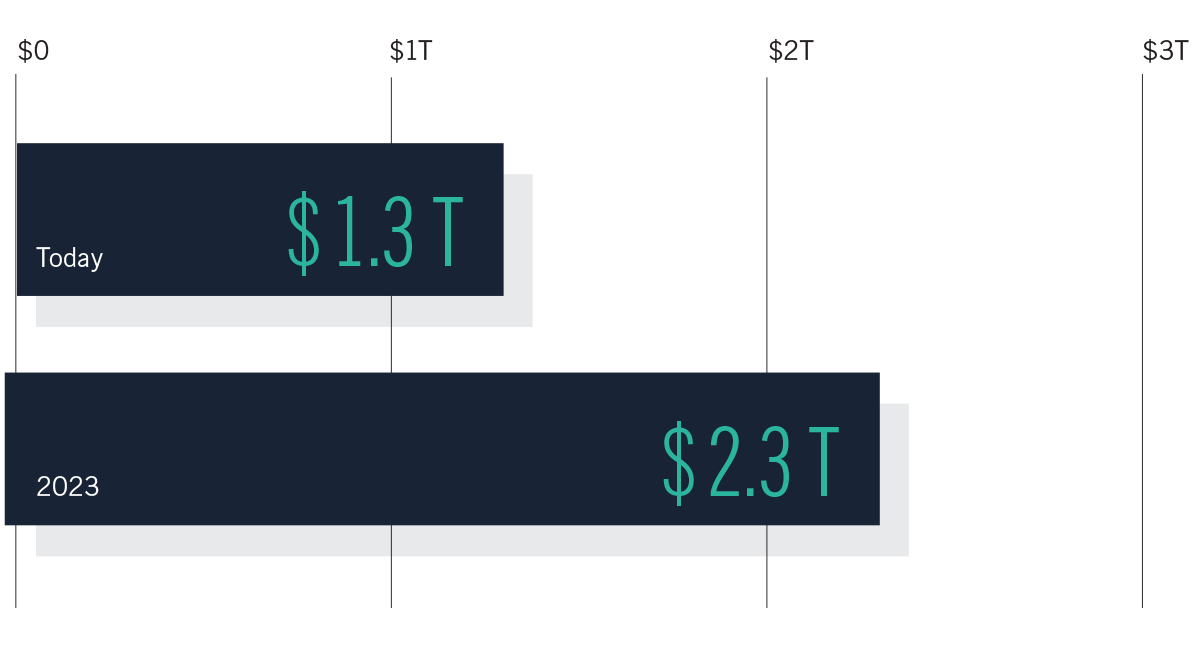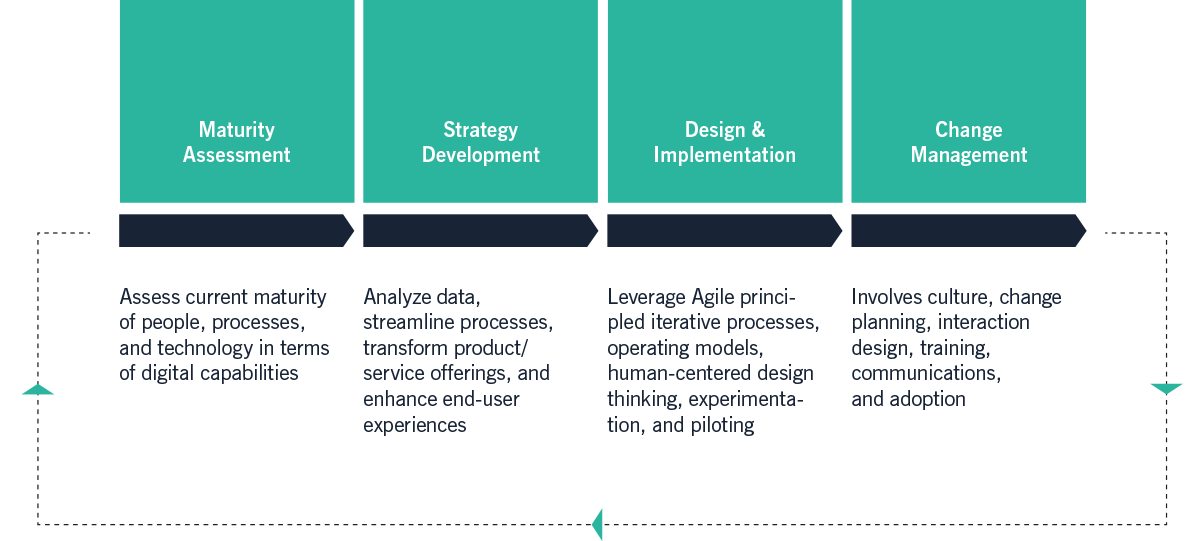I roll up my yoga mat after finishing a morning 20-minute HIIT workout and walk to the kitchen to make a pot of coffee. Five minutes later, fresh cup in hand, I settle into the workday in my office — aka my bedroom. I did not workout at my local gym, as I once did daily. There was no morning banter with the barista at Starbucks. Welcome to working remotely in a pandemic.
Our personal daily routines changed overnight due to COVID-19, but they weren’t the only routines that were dramatically altered due to the pandemic. So were our digital routines. Meetings went from the conference room to the conference Zoom, as entire offices shifted to Microsoft Teams, Asana, and various video conferencing platforms, gym memberships disappeared and turned into on-demand classes, trips to the restaurant turned into ordering from DoorDash or Uber Eats, and shopping turned into curbside pickup and website browsing.
Businesses had to adjust to meet the needs of their customers’ new digital behaviors. For example, consumers became digital shoppers overnight, and businesses had to provide the right e-commerce channels to provide products and services. For employees, video conferencing was widely introduced to the masses as a way of working. This was different from the prior live meetings or even conference calls.
The world looks starkly different today than it did a year ago. And few transformations have moved as quickly in the last year as the world’s path to digital. But what will the future look like for business when the pandemic is over? Will the push to digital persist or retreat?
According to a report by Statista, worldwide spending on digital transformation is projected to grow from $1.3 trillion to $2.3 trillion by 2023. Additionally, 56 percent of CEOs said digital improvements have led to revenue growth.
Digital transformation projected growth

Businesses will look toward leveraging the digital investment and strategic shift in a post-pandemic world. The past year will push the digital trend to persist by growing market/wallet share and reducing the cost to serve. These new purpose-built solutions are aligned to new customer intents that drive customer acquisition, increase customer satisfaction, and foster retention. Businesses will continue to reduce the cost to service through these new and improved digital capabilities by enabling customer self-service, automating manual work, and streamlining of efforts. The influx of new digital consumers forced businesses to align strategic objectives to support new channels due to the pandemic. Additionally, consumers have new consumption habits developed as a result of the pandemic, and businesses will have to continue to satisfy those needs.
Regardless of what the future holds, however, one thing is certain. As the pandemic changed consumers’ demands, companies rose to the challenge and adapted to meet them, especially through e-commerce and digital products and services. Let’s explore two of the most common consumer examples of digital transformation during COVID-19 to uncover the lessons learned and then discuss how they can be applied to your business.
E-commerce and Shopping
Not surprisingly, the demand for online shopping, curbside pickup, and delivery skyrocketed as a result of the COVID-19 pandemic. Initially, curbside pickup and improved logistics through using stores as “distribution centers” helped companies create a revenue substitute when forced to close their stores. And while the increase in online shopping did offset lost revenue, retailers soon found themselves challenged to find new ways to provide an excellent customer experience without being able to interact in person. Apparel retailers began using fit analytics to help customers determine the best size based on a customer’s preferred size for other popular brands. For example, Cole Haan created a fit predictor tool that calculates the ideal shoe size a customer should choose in their brand based on other shoes they own. This type of service builds more trust so consumers are more willing to shop online instead of using the traditional storefront option.
A second major development in the e-commerce space has been the transformation of storefront into distribution centers. For example, Best Buy now provides curbside pickup for online orders that once required shipping. Now customers can buy the product online and pick up it up within the hour, without having to wait two days for shipping. Businesses benefit from increased customer satisfaction as they remain flexible and pivot to navigate the current environment using existing assets and capabilities to meed evolving customer needs.
Restaurants and retailers scrambled to enable and scale delivery of online orders and curbside pickup as consumers avoided in-person experiences. But because forecasting became practically impossible, businesses had to shift their focus and resources to facilitate the impacts on their supply chain and logistics. In fact, many businesses designed promotions to maintain — or even steal — market share from competitors with less mature omnichannel and digital capabilities. For example, Kroger waived curbside pickup fees, while Uber Eats, to help support small businesses, eliminated their delivery fees for local restaurants. Both decisions helped accelerated demand for online orders while requiring companies to continue finding ways to adjust supply chains and delivery methods to reach consumers.
Digital Products and Services
In addition to an increase in online shopping, the demand for digital products and services exploded during the pandemic. Once lockdowns began, businesses quickly converted or shifted focus from physical products and in-person services to digital goods and services. Common examples include fitness, work, and school, which all demanded remote experiences enabled through digital products. As the need for remote capabilities accelerates adoption of digital services and products, companies prepared with such offerings have flourished, while businesses without such offerings have had to strategically invest through mergers, acquisitions, and partnerships.
Peloton differentiates itself through virtual fitness classes enabled by digital products including on-demand and live classes using bikes, treadmills, and/or their app. While Peloton existed prior to the pandemic, it announced a 232 percent increase in year-over-year sales in Q1 2020 alone. Many factors probably influenced these sales, but the increased need for remote experiences must have been a major influence on that sales increase. As Peleton flourished by scaling their existing digital experiences, Lululemon made additional investments and acquired Mirror for $500 million in June 2020. It was noteworthy for two reasons: One, it was Lululemon’s first acquisition ever; and two, Mirror is not an apparel-based company. It’s an at-home fitness company that provides on-demand workout classes, including boxing, weightlifting, dance, cardio, yoga, and more, through a mirror screen. The move marked a significant pivot for Lululemon from a clothing company to a lifestyle fitness brand and addressed the increased customer demand for virtual experiences that arose during the pandemic. These are two examples where a company created a digital offering, like Peloton, or acquired a company that provided that capability, like Lululemon.
Work and school also shifted to virtual environments requiring the use of digital products like Zoom, which by June 2020 had seen a 354 percent year-over-year increase in the number of companies using its products. Zoom experienced increased success from their existing digital offerings, while other companies made acquisitions to meet changing demand. For example, Salesforce acquired Slack for $27B in December 2020 to further enable their online collaboration capabilities. These new ways of learning and working have accelerated demand for virtual meeting and learning platforms, high-speed internet, and increased bandwidth. Companies must scale investments in hardware and software along with updated policies to maintain productivity.


Future Outlook
A post-COVID-19 world will include lingering consumer and working behaviors established during the pandemic. As demonstrated in the examples discussed, tastes, preferences, and behaviors have changed, and businesses must continue to meet those likely permanent changes. The following approach can be used to identify and enable digital transformation in any industry. It includes broad organizational and operational changes leveraging technology to transform processes for improved efficiency and experiences impacting both the employee and the customer. The resulting competitive advantage should provide cost savings from efficiency gains and increased revenue from effective employee collaboration and enhanced customer experience of harmonized channels.
While much of this article has focused on technology, digital transformation must also include consideration of people and processes. The increased use of digital products comes with culture and policy changes in the workplace. While some companies were previously skeptical of remote work, many have already changed their remote working policies to allow more flexibility indefinitely. Individual business units will need to address how this affects their processes to identify any necessary changes to adapt to the potential for a dispersed team. Greater efforts will be required to foster engaging workplaces and a sense of belonging.
A focus on infrastructure and processes could also hedge against any future emergencies requiring the same digital and virtual requirements as were needed during the pandemic. Automation, faster internet speeds, remote collaboration tools, and more flexible supply chains are ideal areas of investment. Data Bridge Market Research stated in a recent report that the global robotic process automation market is forecasted to have a CAGR of 29.2 percent during the period of 2019 to 2026. AI will help generate insights from the massive amounts of data collected through digital actions and will also be used to provide efficiencies in customer service. While innovation in these areas was always on the horizon, the COVID-19 pandemic and subsequent stay-at-home orders clearly accelerated the demand for and the execution of digital transformation in everyday life. As online shopping increased, so too did the demand for remote customer service. Cross-training employees to provide help both online and in-person customers has allowed companies to flex their staff to meet demand. In order to emulate excellent customer service in a digital world, many companies have pivoted to using chat features.
The world may not remain in lockdown forever, but the strategic implications of the way businesses operate will have a lasting impact through digital transformation.
